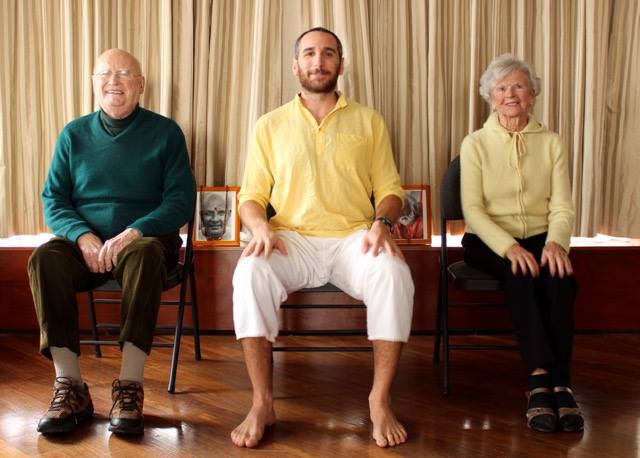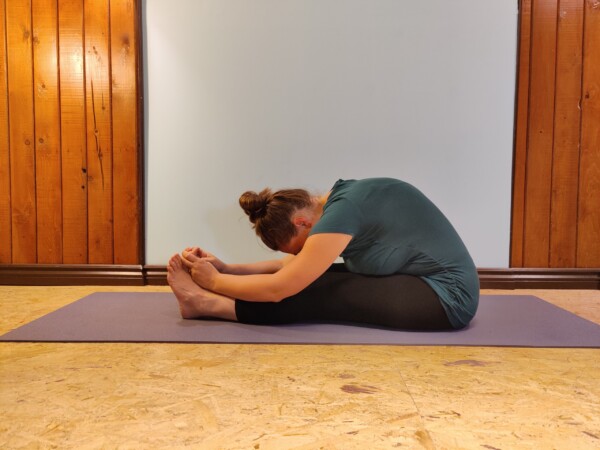New To Yoga
Are you new to the practice of Hatha Yoga?
Hatha yoga, one part of the yoga practice is what most people consider as yoga. It includes all the physical practices, mainly everything you see on a studio schedule or in photos that happens on a mat. The names are many depending on the tradition and marketing, but the goal is always the same. The physical practice of yoga is a practice to help prepare the body and mind for meditation.
Many people come to yoga for the side benefits, such as strength and flexibility, stress management, improved sleep, and improved energy levels. As these benefits begin to come about, practitioners start to notice that their mind is more calm, clear and peaceful.
Get a free handout with the yoga class sequence, so you can practice anywhere, anytime!
Frequently asked questions (FAQ)
Who is Swami Sivananda?
All of the teachings of Michael Hutkins Yoga follow in the lineage of Swami Sivananda and his disciples. Swami Sivananda was one of the first great yoga masters to make the ancient teachings accessible to everyone. He was a medical doctor in India and felt the call to dedicate his life to the yoga path. He left his practice to move to Rishikesh, to be fully immersed in his spiritual practices. After many years of intense sadhana, other seekers started to gather around him to learn. Eventually this became an ashram, in which he created the Divine Life Society. The Society spread the message of yoga all over the world. Swami Sivananda sent many of his disciples to the west, including Swami Vishnu Devananda, who founded Sivananda yoga in the name of his guru.
Swami Vishnu Devananda made yoga easily accessible to the west by describing yoga as follows: “Health is Wealth, Peace of Mind is Happiness, Yoga Shows the Way”, through proper exercise, proper breathing, proper relaxation, proper diet, and positive thinking and meditation.”
What is Yoga Training?
The yoga trainings are further studies for yoga teachers to learn how to make a practice more accessible for students. These trainings are also open to students wishing to learn how to adapt the practice for themselves.
What is Meditation?
Meditation is the practice of observing ones’ own mind to become more aware of its inner workings and eventually have a greater understanding of the self. The definition of meditation is jokingly said to be: a state which cannot be explained. Just as we cannot explain what sleep is, so too meditation has to be experienced. When a practitioner falls into a state of meditation, it is said that they have gone beyond the mind and merged with their inner self, soul, spirit, God, or universal consciousness.
When people practice meditation, they are actually practicing concentration to bring themselves closer to this state of being. The simplest practice of meditation is to breathe in slowly and breathe out slowly. This will relax the body and calm the mind. By practicing regularly in the morning or evening, it is easier to keep the mind calm, clear and focused throughout the day. This will help the practitioner achieve both material and spiritual goals.
In Japa meditation, a mantra is used in coordination with the breath to help focus and uplift the mind.
What to wear?
It is ideal to practice in loose comfy clothing that you could move freely in. Have a sweater or blanket nearby as you might cool down during the final relaxation.
Things you might need for your practice: a yoga mat to prevent you from slipping on the ground and to provide some cushioning if you are on a hard surface. The cheapest ones tend to fall apart quickly, and the expensive ones are not necessary. If you can’t make it t the ground, then a sturdy chair can be a good friend. It is also good to have either a cushion or a block to sit on, if it is uncomfortable to sit for extended periods with your legs crossed. The last item you need, often the hardest to find, is an open mind.
How to practice Yoga?
The practice always begins with the intention of self care. If this intention is maintained throughout the practice, all the benefits will come to the yogi. It is good to challenge the body and mind, but always in a way that respects ones’ own limits.
Expert tip: if your face becomes squishy, it gets harder to breathe, first see if you could relax into the posture or exercise, and if not, this is a sign that it is time to take a pause. Often people say they are not flexible so they can’t practice yoga. This is the same as saying I don’t know math so I can’t got to school. Yoga is a fantastic practice for you if yo wish to improve your flexibility!
What to expect in a Hatha Yoga class?
All classes follow the same structure:
- Initial relaxation
– In initial relaxation, students become aware of their states of body and mind and tune in for the practice - Breathing exercises (Pranayama)
– The breathing exercises help to cleanse the lungs and balance the mind. - Warm up exercises, often sun salutations (Surya Namaskar)
– It is always important to warm up the body before practicing the yoga poses. The warm up exercise, usually sun salutations, help students to get in touch with their physical body, lubricating joints and muscles and raise body consciousness. - Steady poses (Asana)
All of these exercises prepare the body and mind for the yoga asanas, steady poses. - Final relaxation.
What is an Asana (Yoga posture)?
The definition of an asana is a steady and comfortable posture. The longer a posture is held in a steady and comfortable manner, the greater the benefits. Complicated or challenging postures do not necessarily bring more benefits, but rather breathing and relaxing into any posture for a greater amount of time will offer the greatest benefits. The poses are always practiced in a specific order, to ensure equal benefit to the entire body. They also stimulate the energy body in a specific way.
Each posture is practiced with a counter posture, so every muscle group can both contract and stretch, allowing them to relax. Physical tension is also held in the mind, and in this way, not only does the body learn to relax, but the mind as well.
Each class concludes with the final relaxation. This amplifies the benefits of the entire practice and allows the students to go beyond the body and mind. With practice, it is easier to go into the relaxation and experience the inner silence, inner peace.
What are the 5 paths of Hatha Yoga?
There are 5 paths to Hatha Yoga.
- Asanas, Yoga poses. These steady poses help maintain the health of the entire body, muscles, joints, organs, glands, circulatory system, nervous system and more
- Pranayama, Breathing Exercises. The breath is the direct link between the body and mind and in learning to control the breath through specific techniques both body and mind can come into harmony in the present moment. On a more subtle level these exercises are stimulating or balancing the prana or energy flowing within.
- Mudras, hand gestures. Some familiar ones are joining the palms together in prayer position, and touching the thumb and index fingers together, as if saying okay. There are many of these gestures, all of which alter the way static currents flow in the body.
- Bhandas, internal locks. These locks control the movement of prana, energy, within the body. These are practiced when students go deeper into the breathing exercises.
- Shat Kriyas. Internal cleansing techniques. The most common one is perhaps the neti pot, which cleanses the sinus cavities. There are several others for various parts of the body.
Ready to Make a Change?
Get latest information on classes, courses, Teacher Trainings and special offers straight to your email inbox!




